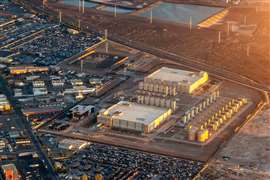Robbins celebrates 60 years in tunneling
04 October 2012

The Robbins Company has celebrated 60 years of tunnel equipment manufacturing. The company was founded in 1952 when miner James S Robbins developed a tunnel boring machine (TBM) designed to make excavation more efficient.
The earliest Robbins TBMs used picks and discs to excavate relatively soft shale at South Dakota's Oahe Dam project. Four years later, Mr Robbins began mounting his TBMs with just disc cutters to excavate harder ground. Canada's Humber River Sewer Tunnel was the first tunnel bored using discs alone, a design the company says is used today for all hard rock TBMs. "A lot of people had tried boring rock up until this time, but no machines had worked. No one could solve that problem-until Dad did," said Dick Robbins of his father James.
Upon the unexpected death of his father, Dick Robbins would go on to serve as Robbins' president from 1958 until 1994. Innovations in this period a TBM for the construction in 1964 of a tunnel on the Paris, France RER network that the company says was the precursor to current Earth Pressure Balance and Slurry TBMs.
Robbins also claims to have designed the world's first Double Shield TBM in 1972. That machine successfully excavated broken ground while simultaneously lining the tunnel with segments to maintain a fast advance rate. Other notable inventions included custom-built machines for mining applications, such as the non-circular Mobile Miner, and raise boring machines.
Today, The Robbins Company develops and manufacturers of a wide range of tunneling products, including small trenchless boring machines, large TBMs to and continuous conveyors for mining applications. "When I started at Robbins in 1968, there were 27 people and we considered ourselves TBM suppliers-nothing but the TBM. Today, we consider ourselves tunnel systems suppliers. We make everything from the cutters at the face to the stacker conveyors at the back," said Robbins' current president Lok Home.
Robbins is continuing its tradition of innovation with a range of new developments, from EPB-specific disc cutters for mixed ground, to specialized ground support, to a new method of TBM assembly. The Onsite First Time Assembly (OFTA) method was first developed at the Niagara Tunnel Project in 2006, where it enabled the swift assembly of the world's largest hard rock TBM (14.4 m diameter). OFTA has since been used on projects around the world, offering time and cost savings through initial assembly of the TBM on site, rather than in a manufacturing facility.





